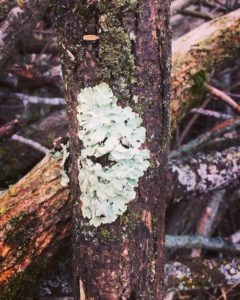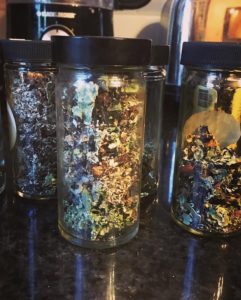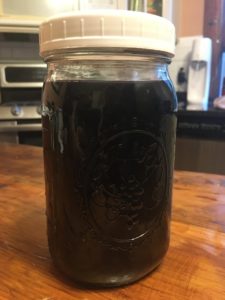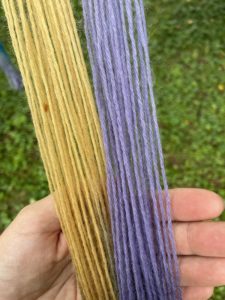September 25th, 2022
This week’s Creative Exploration article is from our dear friend and colleague, Mary O’Connell. Mary has a non-profit farm education program and LifeWays Representative site at Paradise Farm in West Bend, where she and her colleagues provide outdoor, farm-based education to children and adults.
**Editor’s Note: Please wear gloves whenever dyeing fibers and use pots and supplies that are exclusive to dyeing. Do not use the same pots you use for cooking.
Sometimes you learn about something as an adult and you think, “Why did I never know this until now?” This past Spring, I had such a moment.
I was scrolling through my Facebook feed and saw that a colleague from the Pacific Northwest had posted a photo of some lovely yarns she had dyed with natural dyes. There were some beautiful greens, yellows and browns and then this gorgeous bright pink. We’ve been collecting plants and dyeing with them in the Paradise Farm program for quite a few years now and we’ve had lots of fun collecting goldenrod, amaranth, pokeberries and other plants to experiment with, but we’ve yet to find a plant that yields a vibrant red or pink. I asked my colleague how she achieved this gorgeous color and she replied, “Lichen.”
I didn’t know much about lichen, but I was motivated to learn! I learned there are approximately 3,600 species of lichens in North America and those are just the ones we know about. New discoveries are being made every year. Lichens are found all across North America and all over the world. They are some of the oldest living things on the planet. I learned that home dyers all over the world are getting brilliant hues using lichen – each local species yielding a different result.

I had seen lichen growing on the firewood piles composed of dead ash logs at the farm. After doing a bit of research, the kids in my group at Paradise Farm (ages 10-14) began to gather the lichens with tweezers and drop them into old glass spice jars. We had no idea what variety of lichen we had or if this variety was of the dyeing kind, but we were willing to experiment. Although they may seem common, lichens are slow growing organisms with limited habitats so it’s important to gather them carefully and sustainably. We were careful not to take all the lichens and only take them from firewood that was destined for the fireplace.

Once I got them home, I gave the lichen samples a wash and removed as many pieces of twig and dirt as I could, then left it to dry completely, ensuring it was free from mold.
Extracting pigments from lichen is a slow but simple process; it is steeped (or fermented) in an ammonia solution for a period of weeks or months. We used a solution of 2:1 solution of water to household ammonia in a quart sized mason jar. We left some air at the top of the jar and then screwed the cap on.
For the first week, I agitated the jar every day and opened it up to let fresh air in every few days. After the first week it sat on my kitchen counter and every so often I let some fresh air in and gave it a swish. It sat there for six months (I think it was probably ready after four months but I wanted to wait to dye with it until the farm education program was back in session in the fall so I just let it sit.) Over time, the liquid turned brown and then deep brownish-purple.

Before dyeing with the kids, I experimented at home by mixing some of the dye in a small non-reactive pot with water and dropping in a small pieceof wool yarn. I didn’t get too much color (kind of a purplish-brown) so I tried adding some vinegar to the experimental dye pot. This produced a lovely purple!
On dyeing day in the farm program, the kids prepared the dye pot with a quart of strained lichen dye, about 2 gallons of water and a cup of vinegar. After simmering the dye for an hour, a lovely lilac color was the result. We also dyed with goldenrod the same day to get a beautiful yellow-gold color. A successful dyeing day!

I’m still looking for the plant that will yield a vibrant pink but am pretty happy with our lichen experiment!
**Aren’t those beautiful results that Mary and the Paradise Farm’s kiddos achieved? Mary also included this link to learn more about purple lichen dyeing on YouTube. If you have tried dyeing with lichen or decide to try it now, we would love to see your results on Facebook!
Please be careful using any lichens for dyeing. They work to absorb heavy metals in the environment and have been linked with heavy metal toxicity for the elk that consume them in northern regions. The Inuit peoples have become very sick as a result of hunting and eating the elk, which have bioaccumulated heavy metal toxins form the lichens. Any yarn that is treated by lichens might have heavy metals released in the dyeing process.
Oh, gosh. Thank you for that information, Ashley! Perhaps we would recommend using gloves when working with lichen dyes, then!
Exquisite colors, Mary!
Thanks for sharing your exploration. Did you need to mordant the wool? Or do you think maybe the vinegar did the trick?
Hi Susan! I did not mordant the wool. Just the vinegar.
I, too was curious about mordanting the wool or not.